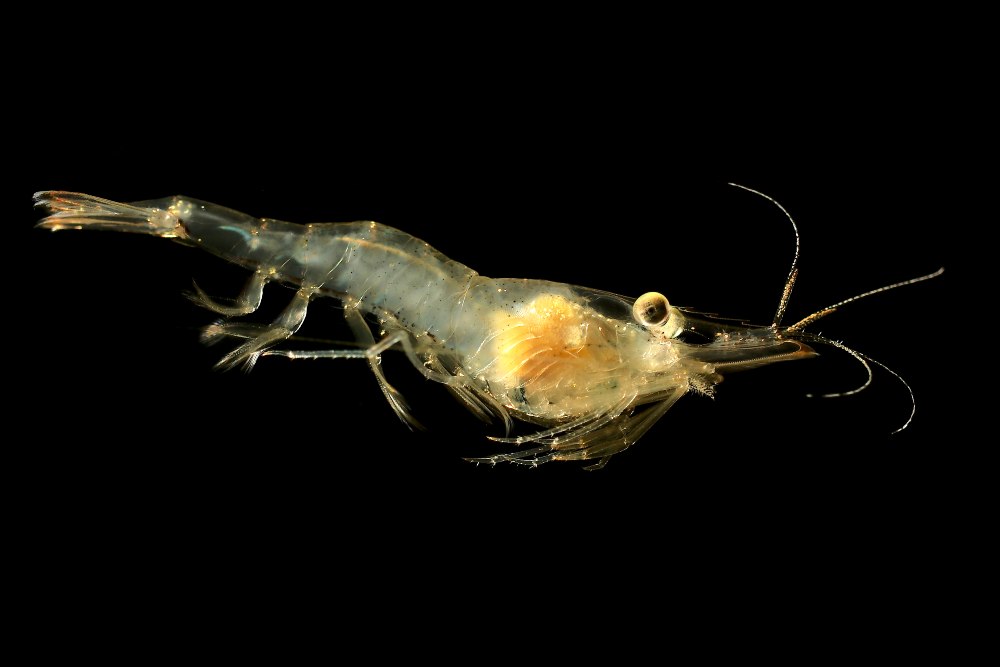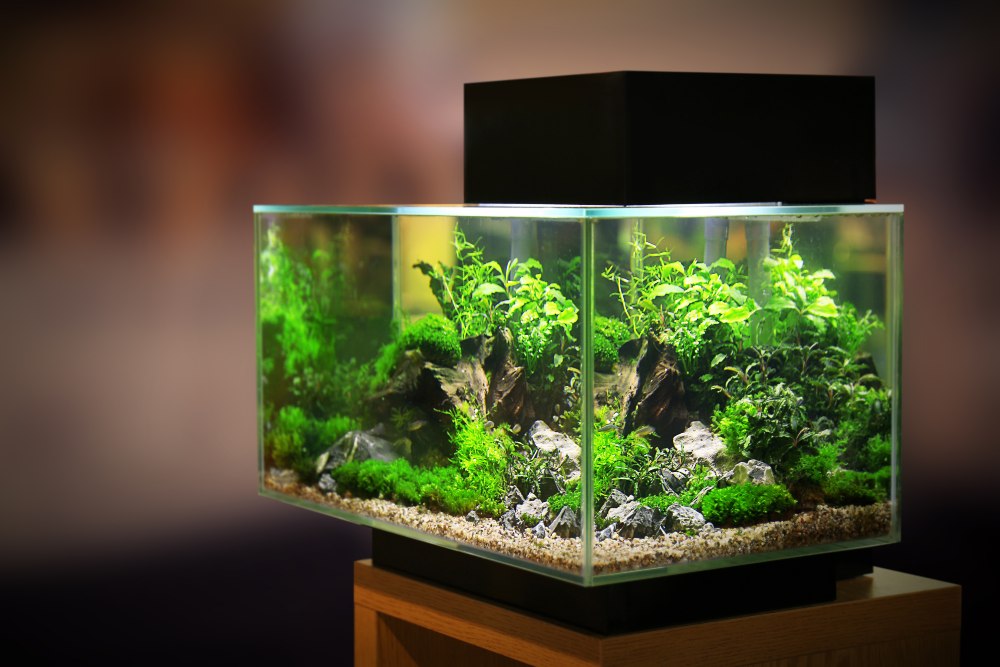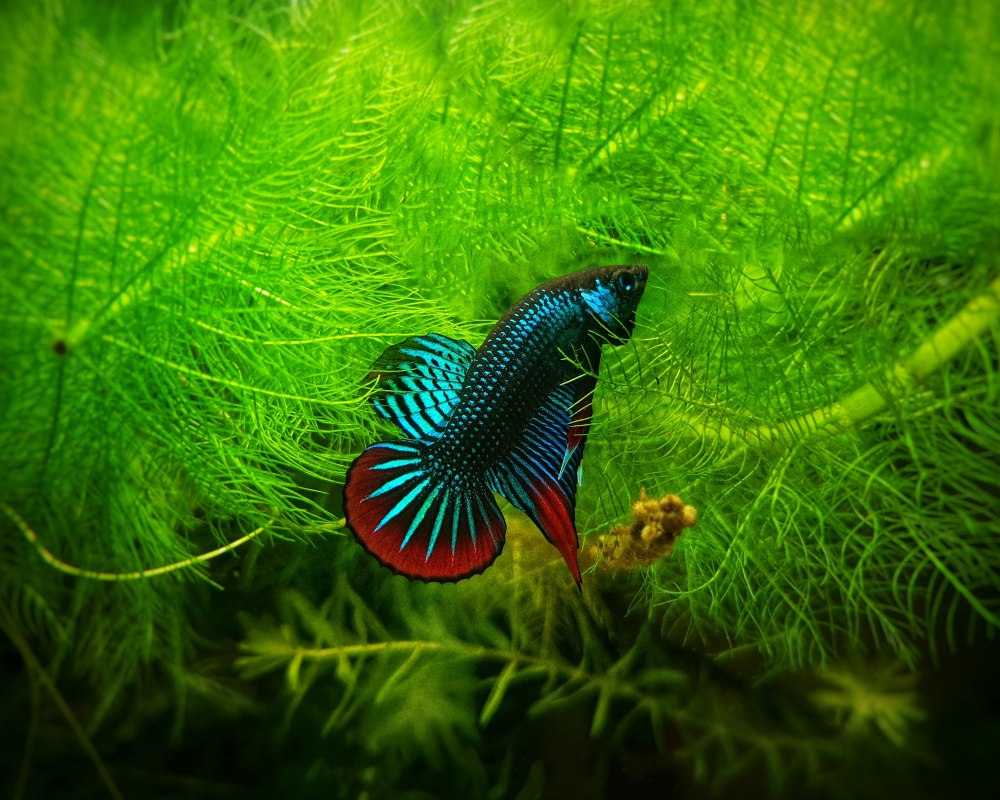Housing your betta fish with other aquatic animals has never been easy. Due to their aggressive nature, bettas don’t do well in community tanks. But there are a few other fish and animal species that will thrive in the betta tank.
According to some experienced hobbyists, shrimp species like ghost shrimp, cherry shrimp, and amano shrimp make excellent betta tank mates. In this guide, we’ll focus only on ghost shrimp and betta fish as tank mates and consider all the pros and cons of keeping bettas and ghost shrimp together.
Ghost shrimp: temperament, habitat, tank requirements, and diet

Ghost shrimp, also known as glass shrimp, is an inexpensive aquarium species. Most hobbyists use them as feeders for larger fish, but did you know they can also serve as a friendly companion for your beta fish?
Temperament
Ghost shrimp are bottom dwellers who spend most of the time hiding. Since they stay in their own territory and do not invade the betta’s space, they are one the best tank mates for a betta.
Ghost shrimp come out of their hiding places mostly during the night since there are fewer chances of it becoming a betta prey. They are docile and friendly, and won’t try to intimate your betta fish.
Natural habitat and identification
Ghost shrimps are native to North America. The ghost shrimp live in both freshwater and brackish water conditions where the water streams are heavily planted. Such water sources with slow currents allow them to graze without getting carried away.
Ghost shrimps are a part of the dwarf shrimp species. Female shrimp grows up to two inches, and the males grow up to 1.5 inches. Ghost shrimp have a transparent body, but sometimes they may display underlying yellow, brown, grey, or green tones.
Tank requirements
Ghost shrimps are easy to keep in aquariums since they don’t need much special care.
But what should be the ideal tank size for ghost shrimps? How many ghost shrimp should there be in a tank?
You can keep at least three to four ghost shrimps per gallon. But when you add a betta fish into the tank, you need to give them a bit more room. A single betta requires a five gallon tank (minimum), so when adding ghost shrimp, go for a minimum five gallon tank with one betta and around 10 to 15 shrimp. This way, everyone gets the space they need.
In terms of water parameters, ghost shrimp belong to tropical waters, so their ideal water temperature is 72 to 82 degrees Fahrenheit with a pH level of 7. Betta fish prefer water that is 75 to 80 degrees Fahrenheit and a pH level of 6.8 to 7.5.
Therefore, the ideal water parameters for a betta and ghost shrimp are:
- 75 to 80 degrees Fahrenheit
- pH of 7
Do not use harsh or strong water filters as the tiny shrimps may get sucked up. Instead, use a sponge filter to keep them safe.
Ghost shrimp diet
Ghost shrimp don’t need food from you. They are great aquarium cleaners, and will feast off the biofilm of rocks, live plants, and driftwood. This works great for tanks with betta fish, which often have lots of live plants.
By adding ghost shrimp into your betta’s tank, you can prevent algae build-up.
The ghost shrimp will also eat any leftover food and waste gathered in the tank’s bottom, keeping the aquarium clean. But sometimes, there may not be enough algae to keep the ghost shrimps full, so use algae wafers to provide them enough nutrition.
Keeping ghost shrimp with betta fish
Is it safe to keep ghost shrimp with a betta?
The answer to this totally depends on the betta fish you have.
Betta fish are extremely territorial, and they generally don’t like to have anyone in their tank.
But their nature may vary from fish to fish. Generally, betta fish are more aggressive towards larger fish species or more colorful ones, like goldfish.
But since ghost shrimp are small with transparent, non-colorful bodies, it shouldn’t bother the betta fish much.
However, being small isn’t necessarily a good thing either…
Betta fish love eating shrimp, and your betta fish might want to snack on the ghost shrimp you add to its habitat.
To prevent ghost shrimp from becoming betta food and to ensure both the species live in peace, here are a few things you must take care of before introducing ghost shrimp as a betta tank mate.
Tank size

Betta fish are very particular about their space.
They need enough room to move freely in the tank, so you should get a large tank, especially when you are keeping a bunch of ghost shrimps in the same tank.
Consider an aquarium of at least ten gallons to let both the betta and ghost shrimp live comfortably. Smaller tanks make the betta fish stressed, and as a result, it can eat the ghost shrimps. Therefore, to keep your shrimps safe, try going for at least a ten gallon tank and, if possible, a bigger one.
Tank decorations
Tank decorations play a crucial role in ensuring that the tank environment stays pleasant. Betta fish are tropical species, so they need a heavily planted tank. You have to add a lot of aquatic plants, java moss, driftwood, enough substrates, and lots of rocks.
Bettas like to engage with their surroundings, and they need a lot of hiding places too. Keeping the tank well decorated will keep the betta fish happy, and it won’t go on attacking its tank mates.
Additionally, plants, rocks, and other substrates will also keep the ghost shrimp hidden from the betta fish and keep them protected.
Keep the betta fish well-fed
Betta fish are eager eaters, so if you keep them hungry, they will go after the shrimp and eat them. To ensure the betta fish does not eat ghost shrimp, you have to keep it well fed. Bettas eat a protein rich food, and they also love treats from time to time.
You should give betta fish pellets, mosquito larvae, live food, frozen food, fish flakes, etc., which the betta loves. If the betta does not get enough food, it will definitely make the ghost shrimp its treat.
How to add ghost shrimp to a betta tank
Adding ghost shrimp to the betta tank should be a slow and steady process. If you add ghost shrimp suddenly in the fish tank, the aggressive betta might attack and eat it. The best way to make both these familiar is by adding the ghost shrimp before the betta.
If you put in the betta fish first, it will consider the whole aquarium as its territory and won’t accept other tank mates. If the betta is already in the tank, remove it temporarily to a separate tank and make some changes in the aquarium so that it looks new.
Plus, you have to ensure you are housing these two species in a larger tank with lots of hiding places. Betta fish can’t adjust in a small tank, and without adequate living conditions, it will get more aggressive towards the shrimp. Also, maintain stable water parameters all the time and keep the tank clean.
Are ghost shrimp and bettas compatible?
Ghost shrimp are compatible tank mates for the betta fish in an ideal tank environment. There is a lot in common when it comes to the living conditions of ghost shrimp and betta fish. Both these are tropical species and prefer warmer waters.
Betta fish need a water temperature between 75 to 80 degrees Fahrenheit, which is quite similar to what ghost shrimp need. To keep both the species comfortable, keep the tank temperature between 75 and 80 degrees Fahrenheit. Betta fish get easily stressed in unstable aquarium waters, so try to maintain the same temperature at all times.
Additionally, betta fish can live peacefully in pH levels between 6.8 to 7.5, and ghost shrimp need a pH level of 7, so finding a balance is not difficult.

Due to their aggressive nature, bettas are also known as Siamese fighting fish, so they can only be kept with docile tank mates. Ghost shrimp’s nature is opposite to aggressive fish, and they won’t invade the betta fish’s space. This again makes these two better tank companions than other fish or other shrimp species.
Ghost shrimp care is also not difficult; in fact, it requires the least amount of care. Plus, feeding ghost shrimp is again very easy. They eat algae and other aquarium build-ups, keeping the tank clean.
But due to the fighting nature of betta fish, there’s always a risk of the shrimp being eaten or getting attacked when you keep them together.
So how do you determine if the betta will attack ghost shrimp?
If you notice your betta taking frequent circles around the shrimps or stalking it, it’s a sign the fish is going to attack ghost shrimp. You can control the situation by feeding the betta fish and distracting it. If the situation worsens, separate the fish and put it in a different tank.
Conclusion
Ghost shrimp and betta fish can be good friends if you house them properly. The only risk is the betta fish eating the ghost shrimp, but with proper betta care, you can prevent or limit that.
FAQs
Yes, the betta will eat the baby shrimp. It’s very difficult to keep them from eating the baby shrimps while they are in the same tank. The only way to protect them is by removing the female shrimp before spawning and keeping it in a different tank.
You can keep ten to fifteen ghost shrimps in with a single betta fish in a 10-gallon tank. Although ghost shrimps are smaller in size, they produce a lot of bioload, so you don’t want too many more than that otherwise the tank might get dirty faster. But you also don’t want less shrimp, as these shrimp enjoy being in groups.
Yes, betta fish will eat ghost shrimp. To avoid this, keep your betta fish and ghost shrimp in a large enough tank and ensure you are feeding your betta fish enough so they aren’t hungry.
Ghost shrimp scavenge the bottom for food and can eat a variety of things, including dead fish, plant material, and other small invertebrates. Ghost shrimp are also known to eat parasites from larger fish and algae within fish tanks.
